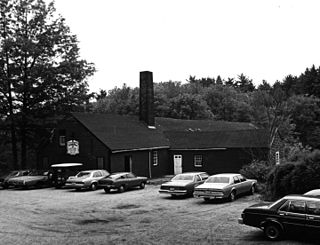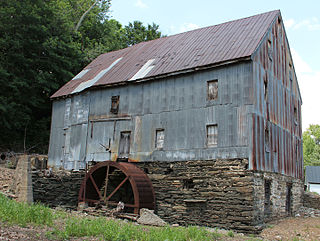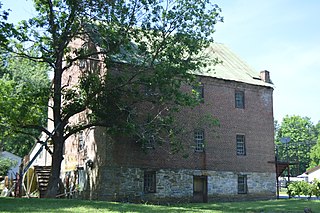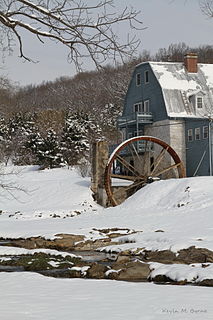
Waterford is an unincorporated village and census-designated place (CDP) in the Catoctin Valley of Loudoun County, Virginia, located along Catoctin Creek. Waterford is 47 miles (76 km) northwest of Washington, D.C., and 7 miles (11 km) northwest of Leesburg. The entire village and surrounding countryside is a National Historic Landmark District, noted for its well-preserved 18th and 19th-century character.

Green Springs National Historic Landmark District is a national historic district in Louisa County, Virginia noted for its concentration of fine rural manor houses and related buildings in an intact agricultural landscape. The district comprises 14,000 acres (5,700 ha) of fertile land, contrasting with the more typical poor soil and scrub pinelands surrounding it.

The Tack Factory was a historic industrial facility at 49 Tiffany Road in Norwell, Massachusetts, United States. With its oldest portion dating to 1834, it was the last surviving 19th-century mill building in Norwell prior to its destruction by fire in 1983. It was listed on the National Register of Historic Places in 1980. For most of its history it was used in the manufacture of horse tack equipment.

Tyro Mill is a historic grist mill located at Tyro, Nelson County, Virginia. It is a multi-story frame mill built in 1846–47 with an addition made in the late nineteenth century. It has a metal-sheathed gable roof and a stone foundation. There is an overshot metal wheel in a stone wheel well and remnants of the head race. The mill contains original machinery including wood gears and drive shafts, two runs of millstones, and a husk frame in the basement gear pit. Also on the property is a mid-19th century log dwelling—traditionally identified as the miller's house—with twentieth century frame additions and front porch.

Beaver Mill is a historic grist mill located near Craigsville, Nicholas County, West Virginia. It was built in 1852, and is a two-story, clapboard-sided, timber-frame structure with an end gable roof. It sits on a stone pier foundation, and measures 25 feet wide and 30 feet, one inch deep. The mill ceased operation in 1932.

Sugar Loaf Farm is an early 19th-century cluster of agricultural, industrial, and residential buildings located in a bucolic setting approximately 7.5 miles southwest of Staunton, Virginia and 1/2 mile southeast of Sugar Loaf Mountain. As a member of the U.S. National Register of Historic Places, Sugar Loaf Farm maintains the only surviving brick grist mill in Augusta County, Virginia. The brick grist mill on the property combines the mechanical principles of Oliver Evans, a prominent mill designer of the late eighteenth century, with the engineering craftsmanship and building detail of molded brick cornices, a vernacular architecture in the upper Shenandoah Valley in the early 1800s. The Farm's three original buildings, the farmhouse, grist mill and miller's house, were all constructed by David Summer at a time when Augusta County had emerged as the center of one of the most dominant wheat-growing and flour-processing regions in the South. Sugar Loaf Farm serves as a valuable reminder of the wheat-based agriculture that persisted in this region well into the twentieth century. Today, Sugar Loaf Farm is a privately run farm that specializes in raising Black Angus cattle.

Oak Hall Historic District is a national historic district located at College Township, Centre County, Pennsylvania. The district includes 17 contributing buildings and 3 contributing structures in Oak Hall. The district includes the mansion house once owned by General James Irvin, the Irvin stone barn, and grist mill site. The Irvin Mansion was built about 1825, and is a 2 1/2-story, five bay limestone house with a center hall plan and gable roof. It features a mix of Georgian and Late Victorian style details. Associated with the mansion are a small shed, wagon shed / ice house, a smokehouse, and privy. The remains of the grist mill were rebuilt as a residence in 1961. Also in the district are the Johnstonbaugh House, Benjamin Peters House, and Garman House (1866).

Mascot Roller Mills, also known as Ressler's Mill, is a historic grist mill complex located at Upper Leacock Township, Lancaster County, Pennsylvania. The complex consists of the mill, miller's house, summer kitchen, and frame barn. The original section of the mill was built in 1737. The machinery was installed in 1906. It is a three-story, "L"-shaped stone building with a gable roof and cupola. The house was built in 1855, and is a two-story, gable roofed brick banked building. The summer kitchen is adjacent to the house is a one-story, brick structure. The small frame barn dates to the late-19th century. It is the oldest continuously operating grist mill in Lancaster County.

Great Valley Mill, also known as the Old Grist Mill in the Great Valley, is a historic grist mill located in Tredyffrin Township, Chester County, Pennsylvania. It was built in 1859, and is a four-story, rectangular banked stuccoed fieldstone structure. It measures 42 feet (13 m) by 45.5 feet (13.9 m), and has a gable roof. It was listed on the National Register of Historic Places in 1983.

Hanger Mill, also known as Huff Mill, is a historic grist mill located at Churchville, Augusta County, Virginia. It was built about 1860, and is a 2 1/2-story, limestone and heavy mortise-and-tenon frame building with a metal gable roof and weatherboard siding. It has an attached one-story office structure. The mill operated until 1940, and retains most of its milling machinery.

Nininger's Mill, also known as Tinker Mill, is a historic grist mill located near Daleville, Botetourt County, Virginia. The mill was built about 1847, and is a three-story, brick structure with a gable roof. Wood-frame additions added in the 20th century, are found on the north and east walls. Also on the property is a contributing simple one-story, wood-frame late 19th-century house. The mill was converted to a restaurant in 1980.

Burwell-Morgan Mill, also known as the Millwood Mill, is a historic grist mill located at Millwood, Clarke County, Virginia. It was built about 1785 by Gen. Daniel Morgan and Lt. Col. Nathaniel Burwell, who both served in the American Revolution. Burwell was the project's financier and Morgan managed the construction. The project overseer was L.H. Mongrul, whose initials and the date 1782 are carved in a stone in the mill's wall. The mill operated until the 1950s. In 1964 it was donated to the Clarke County Historical Association, which finished restoration in 1970 and operates the mill as a museum.
Midway Mill was a historic grist mill located at Midway Mills, Nelson County, Virginia. It was built in 1787 by William H. Cabell (1772–1853), with minor alterations in 1810. It was a 4 1/4-story, uncoarsed ashlar stone rectangular structure with a slate gable roof. Associated with the mill were the contributing stone arch bridge and the late-19th century frame Simpson House. It once stood beside the James River and Kanawha Canal at the halfway point on the James River between Lynchburg and Richmond. It was demolished in 1998.

Crump's Mill and Millpond is a historic grist mill and mill pond located near Talleysville, New Kent County, Virginia. The mill is dated to the 1870s, and is a simple rectangular two-story frame structure with a gable roof. Much of the mill machinery survives at Crump's Mill. It replaced a mill built before 1818 and destroyed by fire in 1872, and remained in operation until 1955. The damming of South Branch in the early-19th century created a large millpond in the shape of the letter "L." The mill sits behind the dam that creates the 16-acre millpond.

Locust Hill is a historic home and farm complex located near Hurt, Pittsylvania County, Virginia. The house was built in two sections with the main section built in 1861, and expanded with a three-story rear ell in 1930. The original section is a 2 1/2-story, three bay, frame dwelling in the Swiss Gothic style. It has a steeply pitched gable roof that incorporates two central chimneys and four gable ends decorated in ornamental bargeboard. Also on the property are a number of contributing resources including a tavern, a servants' quarter, a kitchen, an icehouse, a chicken house, a smoke house, a dairy, a servants' quarter, a caretaker's house, a grist mill, a dam, a family cemetery, and the ruins of an 18th-century house.

Edinburg Historic District is a national historic district located at Edinburg, Shenandoah County, Virginia. The district encompasses 292 contributing buildings, 6 contributing sites, 3 contributing structures, and 3 contributing objects in the town of Edinburg. It includes a variety of commercial, residential, and institutional buildings dating primarily from the time of its incorporation in 1852 to the mid-20th century. They are in a variety of popular architectural styles including Colonial Revival, Italianate, and Queen Anne. Notable buildings include the Philip Grandstaff House (1787), Edinburg Hotel, St. John's United Methodist Church (1916), Edinburg High School (1932-1933), Rush House, The Hatch, Piccadilly House (1850), Pres Grandstaff House, Masonic Building (1879), Harshman House (1900), Rest Haven Inn, Edinburg Train Station, Edinburg Village Shops (1896), Wrenn Building, Edinburg Town Hall (1903), St. Paul's United Church of Christ (1911), and the Mantz House (1930). Located in the district is the separately listed Edinburg Mill.

Lantz Mill, also known as Lantz Roller Mill, is a historic grist mill located at Lantz Mills, near the town of Edinburg in Shenandoah County, Virginia. It was rebuilt in 1865, after being destroyed by Union troops in 1864 during "The Burning", an American Civil War military action conducted by General Philip Sheridan in the Valley Campaigns of 1864. It is a 2 1/2-story frame building erected with post-and-beam construction. It sits on an eight foot high limestone foundation and has a steep standing seam metal gable roof. Four additions were made to the mill in the early 20th century. The mill foundation, mill race (contributing), and mill-dam were constructed some time before 1813. The mill closed in the late-1970s.

White's Mill is a historic grist mill located near Abingdon, Washington County, Virginia. It dates to the mid-19th century, and is a frame two-story structure resting on a down slope basement with a full attic sheltered by a gable roof. It has a Fitz waterwheel and great gear wheel, buhr runs, roller mills, elevators and bolting machinery. Associated with the mill are the contributing earthen race which feeds directly into the wooden race and onto the wheel and an early coursed rubble limestone dam. The mill remains in working condition.

The Stoner–Keller House and Mill, also known as the Abraham Stoner House, John H. Keller House, and Stoner Mill, is a historic home and grist mill located near Strasburg, Shenandoah County, Virginia. The main house was built in 1844, and is a two-story, five-bay, gable-roofed, "L"-shaped, vernacular Greek Revival style brick "I-house." It has a frame, one-story, three-bay, hip-roofed front porch with late-Victorian scroll-sawn wood decoration. The Stoner–Keller Mill was built about 1772 and enlarged about 1855. It is a gambrel-roofed, four-story, limestone building with a Fitz steel wheel added about 1895. Also on the property are the contributing tailrace trace (1772), frame tenant house and bank barn, and a dam ruin.

Valley Mills is a historic building located east of Garnavillo, Iowa, United States. This is one of at least four mills that was located on Buck Creek in the 19th century. They included both grist and lumber mills. The first mill located on this site was a lumber mill built in 1850. A change in ownership and an expansion of the business led to the construction of this grist mill three years later. The two-story structure is composed of roughly dressed limestone, has an exposed basement, and is capped with a gable roof. It was built for B. E. Schroeder and J. H. Kueuzel, who owned the mill until 1867. Kueuzel then held sole ownership into the 1880s. The building was listed on the National Register of Historic Places in 1976.























